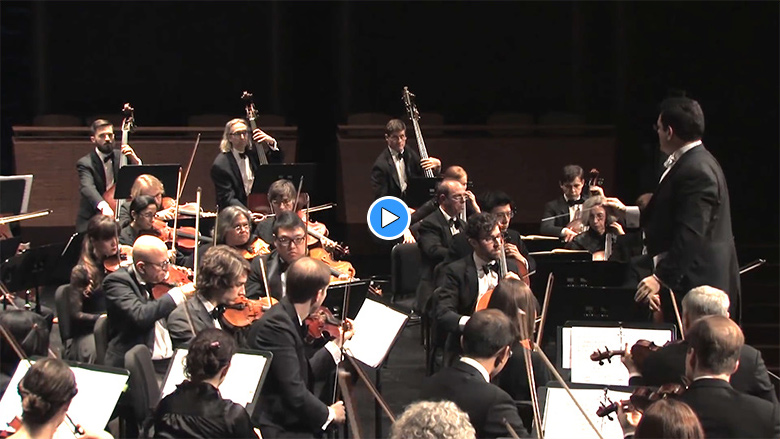Videographer and Video Editor in New York City
Videographer and Video Editor in New York City
in New York City
in New York City
Video Editor
in New York City
In 2013, I have added live streaming video services that allow artists to broadcast their concerts, master classes, festivals, competitions, and other events globally over the internet to thousands of viewers.
When Using a Single Camera
When you need to hire video and audio recording services to film a solo performance, an orchestra, a dance concert, or a choir, and your budget only allows using a single video camera, the following 10 tips will help you to achieve top-quality videos that will be highly memorable and enjoyed for years to come.
- Select an experienced videographer with a musical background who can study the music that you will play in the concert ahead of time. Understanding the music will help the videographer tilt, pan, and zoom the camera to the correct places at the correct times and thereby achieve the most accurate, artistic, and professional results.
- Ask the videographer to show you samples of his work (links to his website or YouTube). This will help you find out whether or not you like his videography style and the quality of his work.
- Ask the videographer to provide you with references or a link to his customers’ testimonials.
- Make sure that the videographer is using a professional, high-definition video camera with a large attached monitor. Using an external, higher-resolution monitor improves the framing of the performance, sharpens the images, and helps the videographer adjust colors and light exposure.
- Unless there is no other choice, do not use a static camera without a videographer. The videographer must monitor the video and control the camera during the entire concert to achieve an interesting and dynamic video with zooming and panning on specific themes at the correct time.
- Ask the videographer to attend a rehearsal of the performance. This will help him or her to better plan the filming of the concert and decide ahead of time where to position the tripod with the video camera.
-
The biggest fear for performers who film their concerts live is making mistakes. The good news is, it is possible to fix mistakes made during the performance by having the performer play the bad sections again and filming the corrections after the concert is over. Then, in the editing process, the videographer can correct these mistakes before burning the final DVD/Blu-ray Disc master. Another
option is to substitute previously-recorded audio from a rehearsal over the mistakes in the original audio from the concert.
-
Audio quality is extremely important. If the venue provides you with a professional audio recording, ask the videographer to synchronize it with the video.
This will give you a better audio recording than what is typically provided by the camera microphones. Camera microphones only provide basic, compressed audio.
-
If the venue does not have audio recording equipment, make sure that the videographer has good audio recording skills and his own professional audio recording equipment.
The videographer can bring professional microphones, which are placed in front of the stage, and connect them directly to the camera.
- Make sure that the videographer can post your video online and on YouTube, edit your performance, and create DVDs and Blu-ray Discs.

Symphony Space, New York
In this example, I filmed the Tribute to Paul Motian using a single camera and the venue's professional audio equipment.
To achieve the best results, I positioned the camera at the back of the concert hall. Then, I panned and zoomed carefully to overcome the lack of additional cameras to produce an effective video.
Paul Motian was a drummer, composer, and bandleader with a profound influence on modern jazz. Click here to read the New York Times review of this event.

Rose Theater at Lincoln Center, New York
The Park Avenue Chamber Symphony was filmed with three cameras. This video clip is featured here to illustrate how using multiple cameras makes a difference. In this video, the challenge was to film the conductor, David Bernard, with the orchestra during the entire concert. Therefore, I placed the cameras in three different locations that helped me film the orchestra and the conductor at the same time for the length of the recital.
Click here to learn about the benefits of filming your performance with multiple cameras.

Blu-ray Disc is the successor to the DVD format. 4K Ultra HD Blu-ray is the successor to the Blu-ray Disc format. Blu-ray Disc offers 5 times the resolution of DVD, while 4K Ultra HD Blu-ray offers 4 times the resolution of Blu-ray Disc. Both formats allow recording,
rewriting and playback of High-Definition content (Blu-ray Disc) and 4K Ultra High-Definition content (4K Ultra HD Blu-ray), storing large amounts of data. Both Blu-ray formats are
currently supported by the world's leading consumer electronics,
personal computer, recording media, video game, and music companies.
All three formats are supported by all Hollywood studios and countless smaller studios.
Co-developed by Sony, Philips, and Pioneer, Blu-ray Disc takes its name from the blue laser
pickup which reads the digital data stored on the disc. Because the blue laser has a shorter
wavelength, data can be stored more densely on a Blu-ray Disc than on a DVD.
Here are the 6 key differences between Blu-ray and DVD:
-
Storage Capacity - The main benefit of Blu-ray Discs over DVDs is
the increased storage capacity. The Blu-ray Disc format offers as much as 5 times the
storage capacity of traditional DVDs. It can hold up to 25GB on a single-layer disc
and 50GB on a dual-layer disc. This increased storage capacity translates to higher
video resolution and audio quality on your TV. Because Blu-ray Discs can store
25GB of data, you can fit an entire HD movie on a single-layer disc.
4K Ultra HD Blu-ray offers more storage than Blu-ray Disc. The 4K Ultra HD Blu-ray format offers as much as 2 times the storage capacity of Blu-ray Discs. It can hold up to 66GB on a dual-layer disc and 100GB on a triple-layer disc. You can fit an entire 4K Ultra HD movie on a dual or triple-layer disc.
The added space that gives both Blu-ray formats better picture quality and audio quality than DVD also gives more room for lots of bonus features. More commentary tracks, deleted scenes, and behind-the-scenes footage are possible with the extra space. Unlike DVD players, Blu-ray players can be connected to the Internet, as well, allowing for Internet-enhanced content.
-
Picture Quality - The DVD format is limited to a resolution
of just 720x480 pixels, which is called SD (Standard Definition). This resolution looks fine
on a standard old "tube" TV, utilizing all available pixels on the screen. However,
if blown up to accommodate a widescreen HDTV, the picture needs to be up-converted
and looks grainy.
Blu-ray Disc resolution can be as high as 1920x1080 pixels, which is called Full HD (High Definition). This superior resolution is what really makes Blu-ray Disc stand out from DVD. A higher-resolution image means the viewers see sharper and clearer images on the screen.
While Blu-ray Disc offers a huge increase in picture quality over DVD, 4K Ultra HD Blu-ray offers even better resolution than Blu-ray Disc. The format supports 4K Ultra HD resolution (3840x2160), which is four times the resolution of what Blu-ray Disc can offer. Furthermore, with the rising ownership of 4K Ultra HDTVs, the clarity and sharpness of the image far surpasses that of Blu-ray Disc. In addition, 4K Ultra HD Blu-ray supports High Dynamic Range and Wide Color Gamut. These technologies allow you to see a much higher range of whites, blacks and shades, with more accurate colors.
-
Audio Quality - Both DVD, Blu-ray Disc, and 4K Ultra HD Blu-ray can store uncompressed audio. However,
both Blu-ray formats' extensive storage capabilities allow it to store more channels of audio than DVD.
To compensate for the lack of storage, most DVDs on the market today use
compressed audio, which results in lower quality audio reproduction. This is critical
especially for the music market, which strives to deliver the best audio quality.
-
Cost - Blu-ray Disc players on the market today sell for as low as $60, costing just $30 more than DVD players. They are extremely affordable. 4K Ultra HD Blu-ray Disc players are also coming down in price, costing around $150 as of December 2017.
- Menus - Both Blu-ray formats offers better interactivity than DVD – specifically, with menus that can run concurrently with the film. For example, while watching the film, the viewer can launch a pop-up menu on the screen and access any part of the content without having to stop playback. This pop-up menu feature is not available on DVD, which requires the viewer to stop playback and access the menu, interrupting the film.
66 Overlook Terrace #3E, New York, NY 10040
Studio: (646) 505-0706 | Mobile: (917) 715-8755 | Email: asafblasberg@outlook.com | Top of Page↑
66 Overlook Terrace #3E
New York, NY 10040
Studio: (646) 505-0706
Mobile: (917) 715-8755
Email: asafblasberg@outlook.com
Top of Page↑
66 Overlook Terrace #3E
New York, NY 10040
Studio: (646) 505-0706
Mobile: (917) 715-8755
Email: asafblasberg@outlook.com
Top of Page↑
